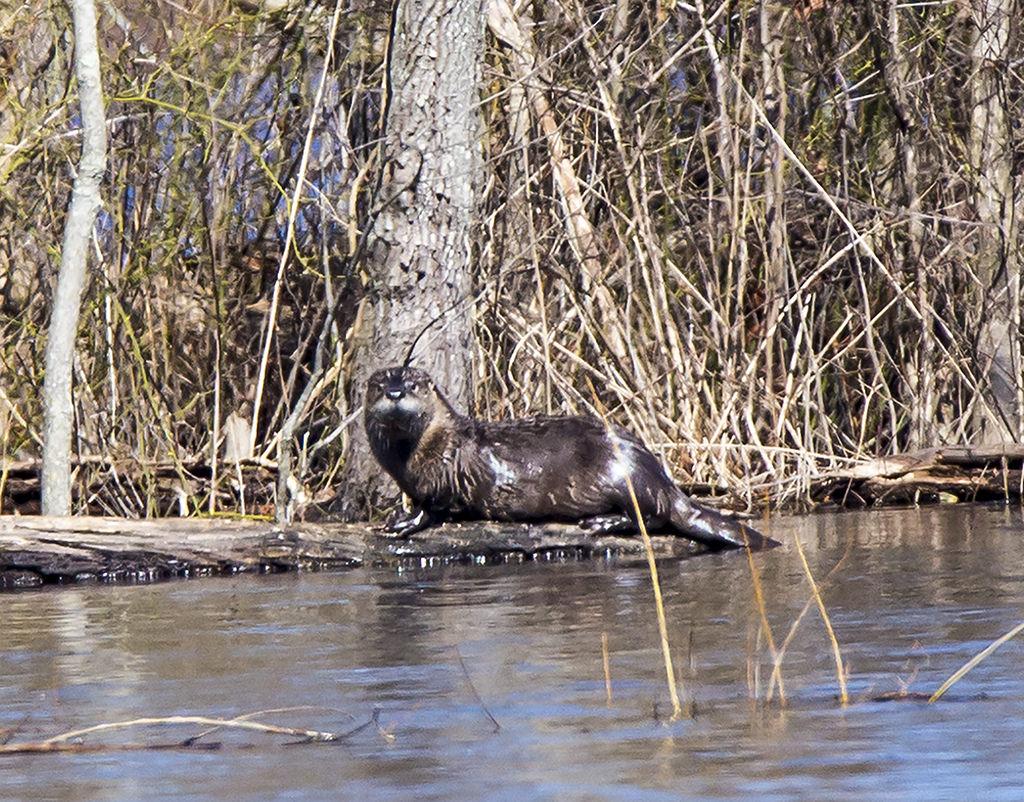Woodland Wildlife Spotlight: North American River Otter
From Fall 2023 issue of Branching Out. Subscribe to Branching Out here. Read more Woodland Wildlife Spotlights here.

River otter in Kent County, MD. Photo by Nancy Wyman, Maryland Biodiversity Project.
Woodland Wildlife Spotlight: North American River Otter
From Fall 2023 issue of Branching Out. Subscribe to Branching Out here. Read more Woodland Wildlife Spotlights here.
If you own waterfront property along the Chesapeake Bay in Maryland, you may have otters in your neighborhood. If your property borders a river, a pond, or a wetland anywhere else in the state, you may have otters in your neighborhood. In fact, any location that has habitat with clean water may be home to otters. While the species is named “North American River Otter,” the animals are at home in a variety of habitats in addition to rivers. They are common throughout the tidal areas of Maryland, but also inhabit streams, rivers, lakes, and both freshwater and saltwater marshes. Otters prefer marshes along wooded rivers and streams, especially those with pools and overhanging rocky banks. Consequently, they are reported in every county in Maryland.
The North American river otter is a semi-aquatic mammal and the largest member of the weasel family. They are relatively nocturnal; although they can be active at any time of day, they are most active in the hours between late afternoon and early morning, which is why many people are unaware of their presence until they discover a physical demonstration that otters have visited. These could be tracks left by their clawed and webbed feet, in sand or snow. Snow– or ice-covered banks may exhibit signs of sliding down to the water. A boat dock or swimming platform may display wet foot prints. Other signs are scat or remnants of their most recent meal.
| North American River Otter Basics |
|---|

Appearance: Long, streamlined body with dense brown fur. Throat and belly silvery brown or golden. Wide, round head, small ears, long white whiskers. Long tail and webbed feet. Size: Adult males up to 30 pounds and 55” in length (including the tail). Females approximately 15% smaller. Lifespan: 8-9 years in the wild; up to 20 years in human care. . |
Their diet is mostly aquatic species, such as fish or crustaceans or crabs, as well as amphibians or the occasional small bird. They are waterborne hunters, and can seal their nostrils shut while swimming and hunting while staying underwater for up to eight minutes. Their whiskers help them find their prey, and they swim in tight circles to create whirlpool-like conditions to bring fish up to them. They capture their prey and then consume them out of the water, such as on a riverbank or on a downed log nearby. They have also discovered that fish and other prey are attracted to boat docks or swimming areas that are lit at night, and will consume their captured meal on these built structures. If they happen to be disturbed by a passing boat or a dog in the backyard, they may emit a short bark, whistle, or growl of their own before diving back into the water.
The river otter’s fur is thick and water-resistant, keeping them well insulated, but unlike their cousin the sea otter, which eats and sleeps at sea, the river otter comes ashore regularly. They create multiple den sites within their territory, using natural openings alongside the water or dens vacated by muskrats, groundhogs, or beavers. Unlike groundhogs, river otters are active year round and cross iced-over bodies of water to reach open areas for hunting.
Males and females are solitary throughout the year until the early spring, when mating occurs during March and April. While gestation lasts two months, the young may be born any time up to one year after mating due to delayed implantation. The female creates a nesting chamber within a den and will give birth to one to four kits in a litter. The young are born fully furred but with closed eyes, which do not open for another month. They are fully weaned at 3 months and leave the den between 6 months and one year of age. While otters are not monogamous, the males often help with the initial rearing of the kits before returning to his territory. The young may stay with the female for a period of time before setting off on their own. Otters may then travel several miles over land in search of a new stream or pond for their new domain.
Young otters are vulnerable to predators such as bobcats and coyotes, but mature otters generally can escape over land to water or defend themselves with their claws. Historically, trapping for their fur, habitat loss, and water pollution had driven them from much of Maryland and across the continent. However, improved environmental and management regulations, as well as reintroduction programs, have contributed to their comeback.
Branching Out, Vol. 31, no. 4 (Fall 2023)
Branching Out is the free, quarterly newsletter of the Woodland Stewardship Education program. For more than 30 years, Branching Out has kept Maryland woodland owners and managers informed about ways to develop and enhance their natural areas, how to identify and control invasive plants and insects, and about news and regional online and in-person events.